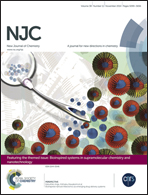Preparation and characterization of fomesafen ionic liquids for reducing the risk to the aquatic environment†
Abstract
The excessive application of pesticides increases the pollution potential, which leads to groundwater contamination and spreading of toxic substances in the environment by leaching or in runoff. In this study, new herbicide ionic liquids (HILs) based on fomesafen with multifunctions were prepared to improve the herbicidal activity and reduce the risk to the aquatic organisms. The octanol–water partition coefficient (Kow), surface activity, soil adsorption and herbicidal activity of HILs were tested and a comparative analysis with fomesafen was made. The results show that HILs have low water solubility, excellent Kow, low surface tension, and good adsorption ability, and these properties can be regulated and optimized by selecting different counter cations. The physico-chemical properties of HILs were related to the carbon chain length of the cation. Compared with fomesafen sodium, ionic liquids N-1 showed a higher and faster herbicidal activity because of its good lipophilicity and low surface tension. HILs with lower water solubility and greater adsorption capacity in soil have less risk to algae, snail and other aquatic organisms than fomesafen sodium. The HILs will be a candidate in fomesafen applications in the future.


 Please wait while we load your content...
Please wait while we load your content...